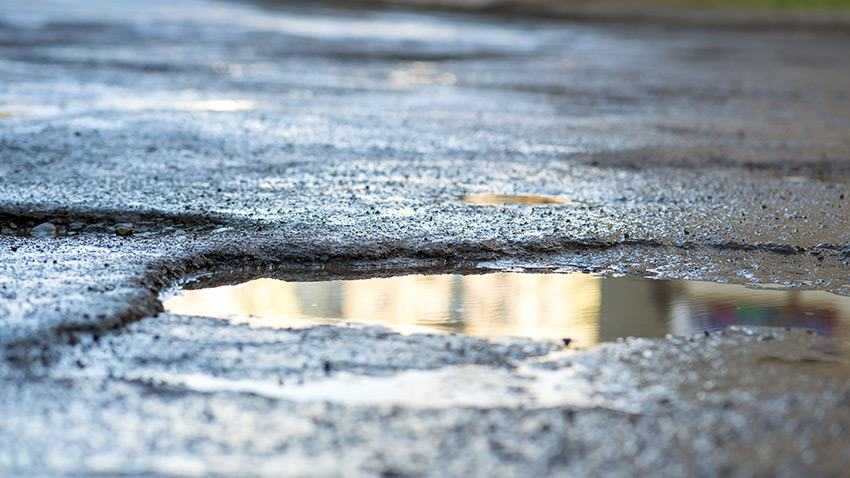
Potholes are virtually everywhere: not just on our roads, but all over our news media too.
We have seen a parade of headlines such as 'Paramedic's anger after pothole takes out ambulance', 'UK roads in 'miserable state' as pothole-related breakdowns surge', 'Potholes are now a conspiracy against drivers' and even 'Richard Madeley rescued by Cornish couple after pothole double blowout'. The first two indicate the seriousness of the issue and the real dangers posed by badly maintained road surfaces. Admittedly, the second two headlines don't indicate much, except that we live in a slightly absurd world.
We look at how potholes happen, why they got so bad and where you should aim your complaints and compensation claims.
What causes potholes?
There are a number of factors that contribute to the formation of potholes, including:
- deterioration of the road surface due to ageing
- extreme weather conditions
- poorly laid and finished road surface
- inappropriate selection of road material
- poor/inadequate maintenance
- wear and tear from high usage
- damage/wear from higher volume and/or weight of traffic than the road was intended to bear
There are several materials in common use for road construction. Of these, concrete is the most durable but it can be prohibitively expensive as well as more difficult and costly to maintain than asphalt. There are several bitumen/asphalt road types, each consisting of layers of different materials topped with the familiar black asphalt. Regardless of materials used, all road types eventually degrade, and all require maintenance.
As surfaces age, they experience wear due to stress from bearing heavy loads and from friction. When surfaces degrade, damage is exacerbated by exposure to extremes of heat and cold and by moisture penetration. Once water gets into the material, repeated freezing and thawing degrades the road further. Loosened material is dislodged and dispersed by traffic, and potholes form.
Complaining and getting compensation
Pothole damage to our cars cost around £474 million last year. Luckily, as the problem is often caused by poor road maintenance, it is possible to seek compensation if a pothole causes damage to your car. Naturally, the process is not as simple or straightforward as we might like.
What you need to know
- deterioration of the road surface due to ageing
- To qualify as a 'pothole', the damage to the road surface usually has to be at least 4 cm in depth.
- You will need evidence that damage to your car was caused by the pothole. A written statement from your mechanic saying that, in their opinion, the damage was due to the pothole is a good start. The more evidence you can get, the better the chances of success.
- Photos of the pothole may help but don't trespass on a motorway or stop your car in an unsafe place in order to get pictures. Either one could get you into trouble.
- Give details of the pothole's precise location if at all possible. GPS or the What3words app can help you pin it down with some accuracy.
- Again, don't do anything unsafe or illegal when getting details. If you can't get specific location information, draw a map showing the pothole's location relative to landmarks such as bridges or buildings.
- Include copies of invoices for repair work necessitated by pothole damage
- For a claim to succeed, the organisation must be at fault. If the pothole has been reported and has existed for some time, then you may have good grounds. Very new damage to the road that may not have been reported yet, or that the organisation has not yet had a reasonable opportunity to inspect or repair, may not be sufficient grounds for a claim.
Who to contact
If you think you have a genuine basis for a claim, you'll need to find out who is responsible for the roads at the location where the damage to your car occurred. The government website gives details of who bears responsibility for roads in the various regions.
- London red routes - Contact Transport for London. Telephone: 0343 222 1234
- Motorways and A roads - Contact Highways England. Telephone 0300 123 5000. Email [email protected]
- B and minor roads - Contact the local council in the area of the pothole. The government website has a tool that can help you contact the correct authority in England and Wales: https://www.gov.uk/report-pothole. The same page contains separate links to help find the relevant organisation in Scotland and Northern Ireland.
Many of the organisations may be able to send you a claim form. Alternatively, forms are often available for download, so ask about that if it's more convenient for you.
It can be confusing trying to work out exactly who is responsible for many roads: it's not always clear. For this reason, we suggest using the government website linked above.
What are the chances of success
In 2022, Fleet News reported that 25% of pothole claims were successful. That might not sound encouraging, but many of those claims will have been lacking in preparation or evidence. If you are diligent in collecting as much detail and evidence as possible, your chances improve.
If your claim is rejected, you can try again. You can submit Freedom of Information requests to obtain records of inspections and maintenance of the road at the location where the damage to your car happened. If additional evidence doesn't convince the authority to settle your claim, you have the option of taking it to the Small Claims Court.
Even if you don't claim
Reporting a pothole can help get it repaired quicker, and possibly save other cars from sustaining damage. It could even prevent accidents. As well as reporting to the responsible authority, many sat-nav apps allow you to report issues and thus to warn your fellow motorists of the hazard.
Insurance implications
You should check your motor insurance to see if there is a requirement to inform your insurer of pothole damage to your vehicle. You should also be aware that you're not allowed to claim twice for the same damage, from both the responsible organisation and your insurer.
